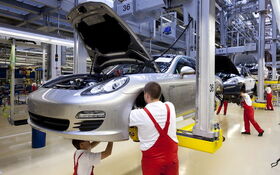Porsche Panamera maximizes production efficiency
Porsche presents new production and logistics system at Leipzig plant
In April 2009, production of Porsche’s fourth model line, the Panamera, started at its Leipzig plant. In the world’s most modern automotive factory to date, Porsche assembles the four-door Gran Turismo and the Cayenne SUV on one line using the latest production methods. At the same time, Porsche has managed to almost entirely do away with expensive storage areas by installing a logistics concept that is an innovation in the industry.
“I know of no other factory anywhere in the world in which the principles of lean production have been as consistently implemented as here in Leipzig,” said Michael Macht, Board member responsible for production and logistics at Porsche, speaking to journalists at the Leipzig plant.
To make production as efficient as possible, substantial building work was necessary at the factory premises, which cover 300 hectares. Porsche invested around EUR 150 million in a new assembly hall, a logistics centre, a pilot and analysis centre and a training facility.
A new logistics concept has been developed for Panamera production. An exact schedule and procedural plan which involves all suppliers makes it possible to deliver parts at high frequency and just one hour before they are processed on the production line. This means that expensive storage areas are virtually unnecessary.
For Macht, the production of the two vehicle types on one production line is a “logistical master stroke.” Almost all the engines for both models are brought to Leipzig by truck from the Porsche plant in Zuffenhausen. Partially-equipped Cayenne bodies come by rail from Bratislava, while Panamera bodyshells arrive by rail from the Volkswagen plant in Hanover. In Leipzig, the interior of the Panamera is assembled on a separate line. Once both bodies have reached the same status in the manufacturing process, they run on one line until completion, despite countless individualization options for both models.
Porsche has consistently implemented the guidelines of a lean factory at Leipzig. Experience from Zuffenhausen, where Porsche had restructured production along Japanese production principles at the beginning of the 1990s, was of particular help. Now, Porsche Leipzig GmbH currently has some 600 staff. In addition to having produced its 250,000th Cayenne this year, the plant also produced 1,270 units of the Carrera GT super-sports car between 2003 and 2006. The facility includes a highly modern customer centre, an FIA-certified racetrack and a 6-km-long off-road track. In the company’s own biotope, 70 aurochs and a herd of wild horses enjoy a peaceful existence as “caretakers of the landscape.”
With the Panamera, Porsche has its eyes firmly set on new groups of buyers from the luxury class. The vehicle is characterized by a high degree of comfort, exceptional space and extremely sporty driving characteristics combined with low fuel consumption. It go on sale in Canada in October, with a starting price of $115,100 for the Panamera S. The all-wheel-drive Panamera 4S is priced at $120,300 and the range-topping Panamera Turbo is $155,000. Porsche plans to sell an average of around 20,000 units of the Panamera each year over the car’s entire lifecycle.












